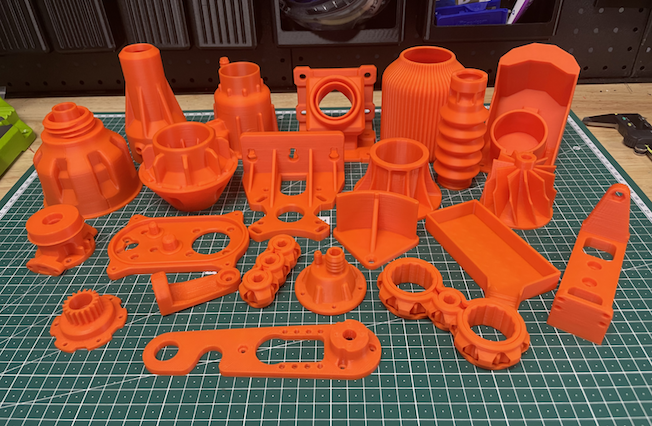ABS (Acrylonitrile Butadiene Styrene) 3D printing filament is a versatile and durable thermoplastic material ideal for a wide range of applications. Known for its exceptional toughness, ABS filament is prized for its ability to withstand impacts, making it suitable for producing rugged, long-lasting parts. It offers excellent temperature resistance, allowing it to maintain its structural integrity under elevated temperatures.

*These parts were printed on the Craftbot FLOW IDEX using a 0.6 mm nozzle at a 0.3mm layer height.
Fuse 3D ABS (Acrylonitrile Butadiene Styrene) is a popular 3D printing filament known for its durability and versatility. The introduction of 3D ABS with enhanced properties like improved hardness, high impact resistance, temperature resistance, and abrasion resistance, such as the Fuse 3D ABS, further expands its applications in various fields. Here are some key advantages and applications of this filament:
- Durability: The enhanced durability of Fuse 3D ABS makes it an excellent choice for applications where the printed parts need to withstand wear and tear, impact, and high stress. It's particularly valuable for producing parts that will be subjected to mechanical loads.
- Hardness: The increased hardness of prints made with Fuse 3D ABS means that they can withstand pressure and maintain their shape, making it suitable for creating rigid components and parts.
- High Impact Resistance: ABS, including Fuse 3D ABS, is known for its high impact resistance, making it ideal for applications where parts may experience sudden impacts or shocks without breaking or deforming.
- Temperature Resistance: ABS can tolerate higher temperatures compared to some other 3D printing materials, which makes it suitable for applications where parts may be exposed to elevated temperatures or direct sunlight without deforming or losing their properties.
- Abrasion Resistance: The resistance to abrasion means that printed ABS parts can endure friction and wear over time, making them suitable for applications in which parts encounter other surfaces regularly.
- Concept Models: Designers and engineers can use Fuse 3D ABS to create concept models for new products, allowing them to test and refine their ideas quickly and cost-effectively.
- Prototyping: ABS, especially when combined with 3D printing technology, is widely used in the prototyping phase of product development. Engineers can rapidly iterate and test designs, ensuring that the final product meets their specifications and requirements.
- Production: ABS can also be used in limited production runs for creating rigid components and parts where injection moulding or other traditional manufacturing methods might be too expensive or time-consuming.
In summary, Fuse 3D ABS, with its enhanced durability and resistance properties, offers a wide range of applications for designers and engineers. It can be used for concept modelling, prototyping, and even in some production scenarios where its specific properties meet the requirements of the application. This makes it a valuable material in the 3D printing world, particularly for projects that demand robust and long-lasting parts.
Currently available in 11 assorted colours, as more colors become available for Fuse 3D ABS, it expands the creative possibilities and practical applications of this filament, making it even more versatile for a broader range of projects and industries. Users can choose the colors that best suit their design and functional requirements.

